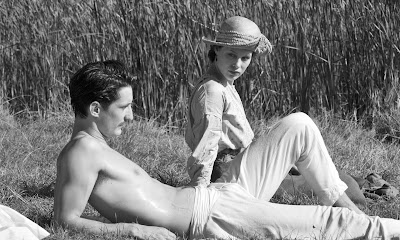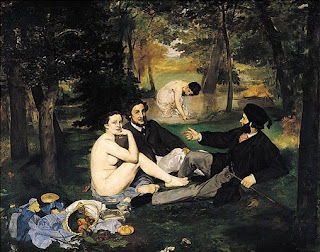I loved the new François Ozon film,
Frantz. The movie stars Paula Beer and Pierre Niney and is mostly in black and white. It is a mystery of sorts. It takes place in Germany in 1919 after WWI and concerns a strange French mourner, Adrien, who has come to weep at the grave of Anna's dead fiancé.
The mourner haltingly develops a relationship with Frantz's family and Frantz's fiancé. He was Frantz's friend in Paris, he tells them. But it is clear from the very beginning that Adrien is taking Frantz's death much harder than he ought to be taking it. We will find out what their real relationship was as the film continues, but
Frantz is a film consisting of a series of parallels. Images, situations, languages are doubled in the film, ghosting each other. There is always another side to every situation in the film, there is a second ghost for every one we meet.
Frantz is divided neatly in half by the revelation of Frantz and Adrien's real relationship midway through the film, and from there Ozon has more surprises in store.
Frantz, it should be noted, is not an action film. It is a slow, sad, romantic film that is more about the ghosts of World War I than it is about anything else. But Ozon is doing wonderful work, and his use of color in
Frantz is absolutely astounding.
The rest of this post will have spoilers.
* * * *
What I love about Frantz is the way everything in the movie is doubled. When we're first in Germany we feel sorry for Adrien and Hans Hoffmeister as they try to talk sense to the Germans who hate the French and spit at them. Their singing and nationalism seem scary but also ignorant and stupid. How easy it is to look down on the Germans, who, after all, would start the next war. But when Anna goes to Paris she encounters precisely the same thing. The train car attendant glares at her, the French woman with her children looks at Anna in disgust. And then in the bar all the patrons stand and sing "La Marsellaise". It's actually terrifying. And we are not in a tiny German town. This isn't a little burg somewhere: this is Paris.

The French and the Germans are doubled in Frantz, certainly, as Adrien is Frantz's double, but Ozon also doubles the dead for whom we are asked to mourn. Frantz himself, whom we grow to love, even as he fades more and more persistently from the film, but then when we meet Fanny, we find that her brother, too, was killed in the war, a boy even younger than Frantz who, of course, is named François. The film is insistent that we understand World War I not as a series of aggressions in which France and Germany fought one another but as a disaster that befell a generation of men because their fathers willed it so. What is France? What is Germany? the film asks, other than the happiness of its young people?
Ozon's use of color and black-and-white is, perhaps, Frantz's most striking feature. Ozon is a theatrical director, and it is here where his film betrays his flair for excess, but in Frantz this is understated and subtle, and Ozon uses it to such perfect effect. The work here is a kind of gorgeous tribute to Douglas Sirk, and Frantz is certainly a melodrama. The very first shot of the film is in color, even though it looks like it is in black-and-white. We see pale pink flowers as we look at the image of a nearby town in a gray morning sunshine. It is a trick of the light – the kind Melville pulls in Le Samouraï. Then we meet Anna and the film is firmly in black-and-white. But the film becomes a color film when the oppression of grief lifts momentarily. As Adrien first tells the Hoffmeisters about his trip to the Louvre with Frantz, we see the boys run and cavort in the palace, and the film soars in color as we watch them. We return to the present and return to black-and-white, of course, but the next time Adrien tells a story about Frantz we are again in color as Adrien lovingly moves Frantz's hands as he teaches him violin technique.

The first time the present day switches into color took everyone in the theatre by surprise. Anna and Adrien walk through a shadowy underpass and as they emerge, we are in color. The switch is so subtly done that the people next to me only figured it out forty seconds in, at which point they gasped. It's a gorgeous sequence of events, and Anna's happiness is made beautifully evident. We've been desperate for her happiness for most of the film and we hadn't realized it. After we have found out the truth and Adrien has gone back to France, Anna walks that same path on the way to commit suicide. The shots are doubled. She covers the same area alone, paces a field, crosses through the underpass, and when we didn't switch to color this time, I couldn't help but cry. It is all black-and-white for Anna.
There are more doublings in the film – the entirety of Frantz hinges on a kind of double story of possibility: what might have happened if the war hadn't existed, if Adrien hadn't killed Frantz, if Adrien hadn't been French and Anna German, or if those things didn't matter, if Adrien had married Anna instead of Fanny. These worlds exist in the film, though, because we are told about them; all of these worlds are described beautifully to the Hoffmeisters, who believe them. But the film plays with these fantasies and allows us to project our own desires onto these characters as well. I will confess that I hoped that Frantz and Adrien had been lovers. This mysterious, beautiful man, who wept so easily, so copiously while talking about Frantz. Surely, I thought, their relationship had been sexual. In the fantasies Adrien spins for the Hoffmeisters, the first painting we see in the Louvre appears to be one of Sebastian, that patron saint of queer men. In these beautiful, colorful fantasies, Adrien looks at Frantz with such absolute love that it is heartbreaking, and after he kills him, he lays on top of the other man like a lover, caressing his face.
 |
| Le Suicide |
Ozon plays with these fantasies, and we project them continually. I came to feel that our projections were the very purpose of Frantz, who is, after all a projection himself.
Adrien finally kisses Anna and it seems that, perhaps, the two might make a life together. My heart followed that fantasy, hoping it could be possible. No, Anna says, it is too late. But then she writes to the Hoffmeisters precisely the opposite. She has met Adrien in Paris, she says, and he is playing with the Orchestre de Paris, and she is accompanying him on the piano. We know it isn't true. Or do we? At the film's end, Anna returns to the Louvre; she walks toward the two Manet paintings on the wall, the Dejeuner sur l'Herbe and Le Suicide, and we see the back of a young man's head. It is Adrien, we think! They are together again. He has left Fanny, and she is meeting him at the Louvre. All will be well. It is not him, of course, and what becomes clear to me is that it is I who am living in the fantasy world, here. It is I who wish for reality not to matter, hoping the pair can find each other, dreaming that out of the pain of the war something beautiful can be created.
 |
| Dejeuner sur l'Herbe (Le Bain) |
One last double. Above the Manet painting with which Frantz ends is another, more famous Manet canvas, the Dejeuner sur l'Herbe. This is not the focus of Anna's happiness, apparently, but it is a double of Le Suicide. Indeed, Ozon replicates the image of the painting in his own film. Adrien – in color, although the image above is in black-and-white – comes out of the water like the woman in the back center of the painting, and he lies, as you can see above, mostly naked with one knee up, like the woman in the foreground of the image, while Anna, fully clothed and wearing a hat, sits and looks at him. Manet's painting was originally called Le Bain, and Frantz hints at this swim as an image of togetherness for Anna and Adrien, as she asks him to teach her to swim. "I was waiting for you," she says. It is an image of happiness and life that is the opposite of the suicide she chooses when she walks into the water.
But what of the ending? The Louvre is oddly empty, so perhaps we
are, again, in a fantasy. Who is the weeping young man with Anna staring at Le Suicide?
Is it François, a dead man slightly younger than Adrien? Or is it
someone we do not know at all? Perhaps she is dead. Le Suicide, Anna
says, makes her happy, and, indeed, the film switches to color again for
a last look at Anna and then the painting. (Well, mostly color. The painting is
framed on both sides by a gray wall. It is a color shot that is also partially a black-and-white shot, an echo of the trompe l'œil of Frantz's
first frame.) If the film has moved back to color, Anna is, truly,
happy, but all we have are our fantasies about what might have happened.
Has Anna committed suicide – that is, after all, the painting's own
title – or has she simply left behind the Hoffmeisters, Frantz, Germany,
and Adrien, attempting to make a life for herself in Paris on her own?
Is her letter about living in Paris and playing the piano partially true
after all?












